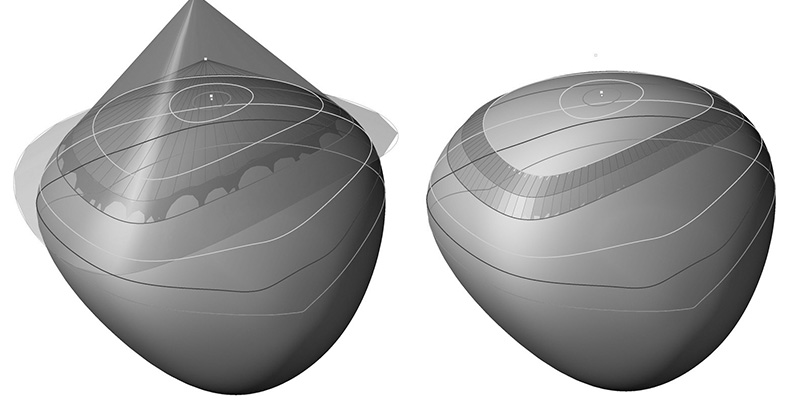Downloads
DOI:
https://doi.org/10.7480/jfde.2015.1.919Keywords:
Freeform surfaces, double curved surfaces, developable surfaces, algorithmic approachAbstract
Almost all industrialized materials commonly employed at engineering and building construction are approximately unstretchable, metal sheets, plywood or glass. So there is no doubt about the advantages offered, mainly from the economic point of view, by the processes that use flat or developable surfaces in the resolution of doubly curved ones. Using two prototypical kinds of developable surfaces, an adaptation method of double curvature surfaces is formulated using either developable strips or planar quadrilateral surfaces. Through the geometric concept of apparent contours and by the systematization of a process inspired by traditional projective geometry an algorithm is built, using the newest and outstanding CAD processes. They systematize and allow obtaining single-curvature strips or flat facets, in order to be able to address its construction, using materials that can be bent in one direction or rigid material with no possibility of being bent at all by simple and economical procedures. These strips obtained are from the geometrical viewpoint absolutely developable. They are patches extracted from cones or cylinders. The main subject to be developed in this paper is on one hand showing of the system and its geometric basis and on the other the exhibition of the results that are being obtained over physical models and prototypes built in diverse materials.
How to Cite
Published
Issue
Section
License
Copyright (c) 2015 Francisco Gonzalez-Quintial, Javier Barrallo, Ana Artiz-Elkarte

This work is licensed under a Creative Commons Attribution 4.0 International License.
Authors or their institutions retain copyright to their publications without restrictions.
References
Glymph, J., Shelden, D., Ceccato, C., Mussel, J., & Schober, H. (2004). A parametric strategy for free-form glass structures using quadrilateral planar facets. Automation In Construction, 13(2), 187-202.
González-Quintial, F. (2012). Método de adaptación de formas de doble curvatura mediante superficies desarrollables. Doctoral Dissertation, UPV-EHU.
González-Quintial, F., & Sánchez Parandiet, A. (2013). Freeform surfaces adaptation through developable surfaces using apparent contours. Global design and local materialization. Proceedings CAAD Futures (2013), Shanghai, China, 358-367.
Grasshopper (n.d.). Algorithmic modelling for Rhino. Retrieved April 26, 2015, from http://www.grasshopper3d.com/
Izquierdo Asensi, F. (1980). Geometría descriptiva superior y aplicada. Madrid: Dossat.
Izquierdo Asensi, F. (1995). Geometría descriptiva. Madrid: Paraninfo.
Kilian, A. Embodied Intelligence. Final Project. Using Genetic Algorithms To Generate Developable Strips From Free Formed Surfaces. Overview of Projects. (n.d.). Retrieved April 26, 2015, from http://www.designexplorer.net/
Pottmann, H., & Bentley, D. (2007). Architectural geometry. Exton, PA: Bentley Institute Press.
Pottmann, H., Schiftner, A., Bo, P., Schmiedhofer, H., Wang, W., Baldassini, N., et al. (2008). Freeform surfaces from single curved panels. ACM Trans. Graph., 27(3), 1.
Shelden, D. (2002). Digital surface representation and the constructability of Gehry’s architecture. Doctoral dissertation, Massachusetts Institute of Technology, Department of Architecture.
